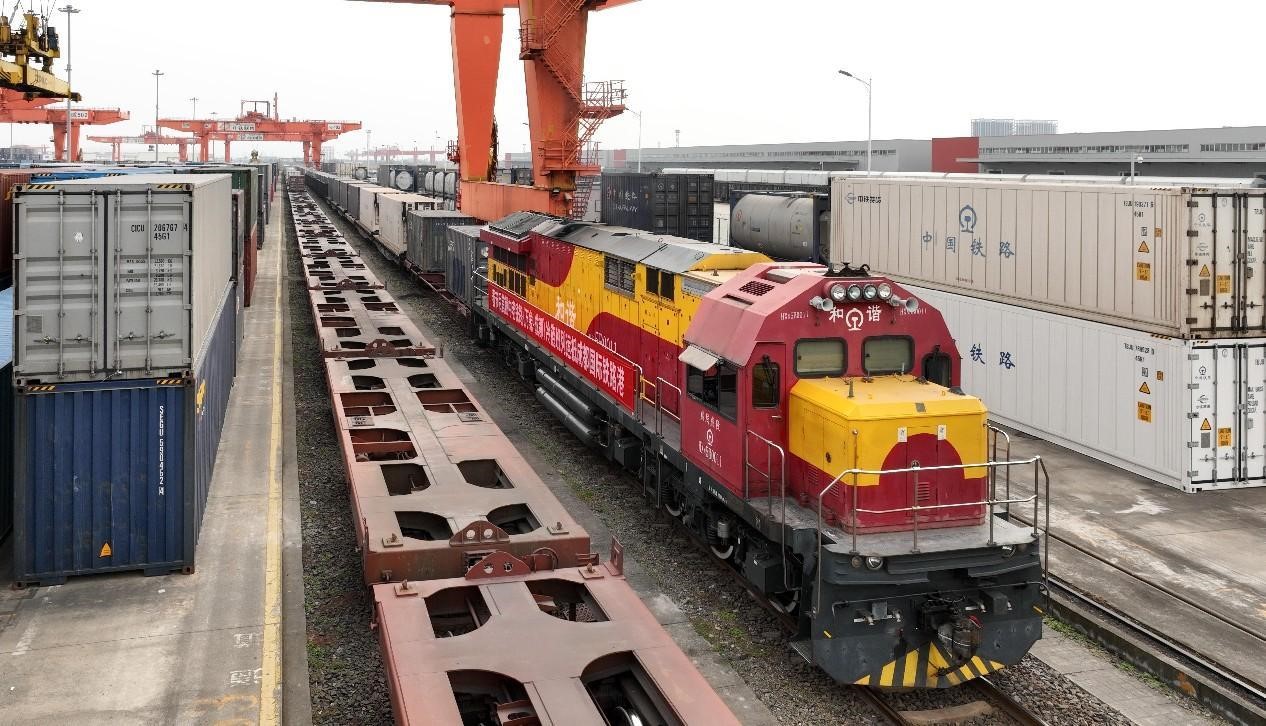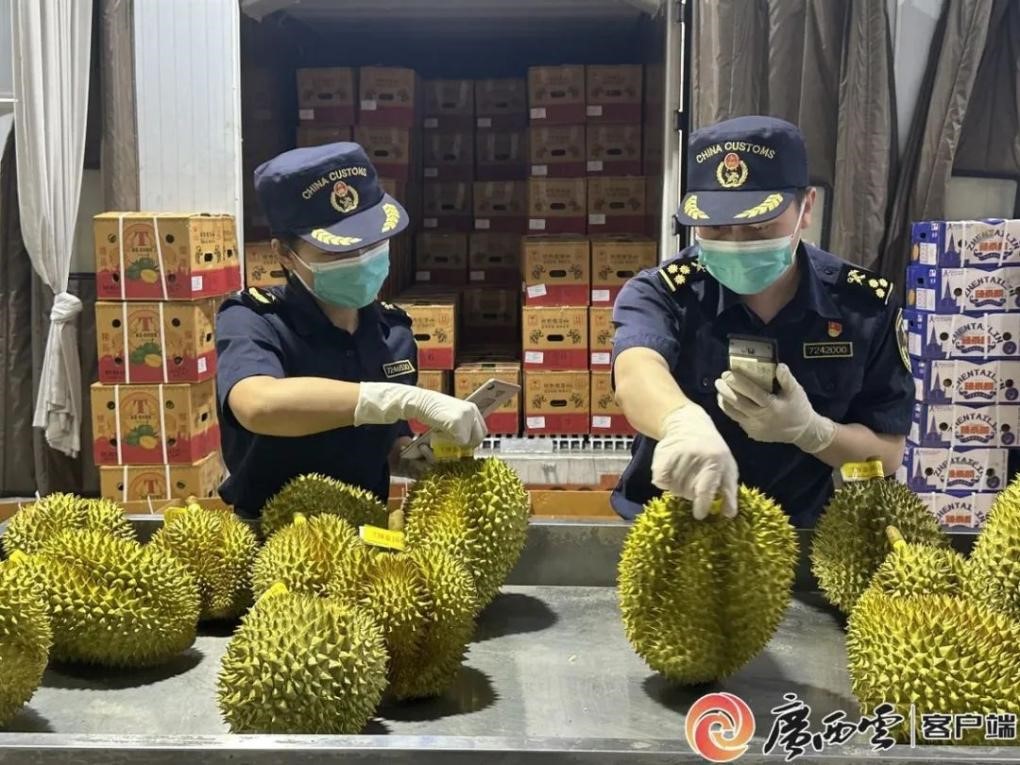More fruits around world find way into Chinese market as China expands opening-up efforts
Durians from Thailand and Vietnam, cherries from Chile, kiwifruits from New Zealand, avocados from Kenya... Today, more and more seasonal fruits from around the world are being sold in China's wholesale markets and supermarkets, enriching the choices of Chinese consumers.
According to statistics, 19 countries and regions had signed agreements on the inspection and quarantine procedures and requirements of exporting fresh fruits to China as of the end of 2023, which covered over 20 types of fresh fruits.

A train carrying fresh fruits arrives in Chengdu, southwest China's Sichuan province via the China-Laos Railway, Feb. 24, 2024. (People's Daily Online/Bai Guibin)
Driven by favorable policies, China's fruit imports last year amounted to $16.85 billion, a 15 percent increase from a year ago. The country sourced more than 7.5 million tons of fruits from around the world, up 3 percent year on year.
Recently, a freight train of the Lancang-Mekong Express, consisting of 37 twenty-foot equivalent units of containers fully loaded with fresh fruits, arrived at a border inspection area in Mohan, Mengla, southwest China's Yunnan province, after passing through the Friendship Tunnel of China-Laos Railway. It took only 16 minutes for the border inspection officers to complete the entry inspection for this train.
Currently, Southeast Asian countries are in fruiting season, and fresh fruits are entering China through the China-Laos Railway via Mohan almost every day. Statistics show that since the beginning of this year, over 2.48 million tons of cross-border cargos have been transported along the China-Laos Railway, increasing 21.7 percent year on year. In particular, 82,281 tons were imported fruits.
The increase in the volume of imported fruits means a need for faster customs clearance. An official with the Mengla customs said that the customs department has been working to establish a "declaration in-advance" mechanism for railway imports. It has also implemented reforms to expedite railway customs clearance and deployed intelligent supervision and inspection equipment, to strike a balance between strict inspection and efficient customs services.
Faster customs clearance has brought enormous convenience to fresh fruit importers.
"In the past, when our company imported Southeast Asian fruits like durian, mangosteen, and longan via the Mohan highway port, our biggest concern was always the lengthy customs clearance process as the fruits may lose their freshness," said Wang Xiaowu, head of a foreign trade company in Mohan.
"Now, with the Lancang-Mekong Express international freight train, it takes only 26 hours from Vientiane, Laos to Kunming, Yunnan province. The customs clearance time has been reduced by 80 percent, cutting costs by nearly 30 percent," Wang added.
The business of fresh fruit imports exactly mirrors the big strides made by China in opening up.
On Jan. 1, 2022, the Regional Comprehensive Economic Partnership (RCEP) officially came into effect. Under relevant favorable policies, agricultural trade between China and other RCEP member countries has continued to heat up. Some imported fruits are arriving in China via chartered ships and planes.

Customs officers inspect imported durians in south China's Guangxi Zhuang autonomous region. (Photo/Huang Lina)
According to statistics, New Zealand-based kiwifruit marketer Zespri International Limited is expected to export 1.4 billion kiwifruits to China this year. Besides, Pakistani cherries, upon arriving in northwest China's Xinjiang Uygur autonomous region, are hitting Chinese cities like Shanghai through direct flights.
Thanks to major platforms like the China International Import Expo and the China International Consumer Products Expo, Belgian red conference pears, Peruvian blueberries, and Ecuadorian yellow dragon fruits have entered the Chinese market for the first time.
In Chanthaburi Province, Thailand, the owner of a durian orchard has started selling the fruits via livestream on Tmall, an online shopping platform under Chinese e-commerce giant Alibaba.
The province is one of the major durian producers in east Thailand, and the orchard is a smart fruit garden jointly developed by Thai Sustainable Agriculture Trade Association and the Foreign Economic Cooperation Center under China's Ministry of Agriculture and Rural Affairs.
The Internet of Things devices in the orchard constantly monitor important data such as weather conditions, water levels, and soil moisture, providing support for science-based durian cultivation.
The Chinese partners of the orchard have also helped Thai fruit farmers engage in livestream commerce. According to statistics, during this year's "618" mid-year online shopping festival, which fell on June 18, durian sales on Tmall Supermarket increased fourfold compared to the previous year, with peak sales reaching over 50,000 durians in a single day.
Today, more and more Chinese and foreign partners are establishing cooperative relationships to ensure fruit quality from the source.
In Southeast Asia, some companies are employing digital technologies and dispatching procurement teams and buyers to monitor fruit quality at every stage, from orchard cultivation to production, packaging, and transportation.
In Africa, "green channels" for agricultural exports to China are being set up, with African fruits like Egyptian oranges and kiwanos successively entering the Chinese market.
As Chinese agricultural technologies and high-quality fruit varieties make their way to South America, local fruits such as Chilean cherries and Peruvian blueberries are also hitting the Chinese market.
Experts believe that Chinese consumers' willingness to pay for high-quality and featured imported fruits presents a huge opportunity for fruit-producing countries worldwide.
As China continues to expand its opening up and introduce favorable policies such as tariff reduction and faster inspection and quarantine processes, more fruits from around the world will find their way into Chinese consumers' "fruit baskets."
Photos
Related Stories
Copyright © 2024 People's Daily Online. All Rights Reserved.









